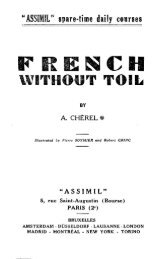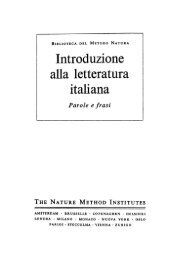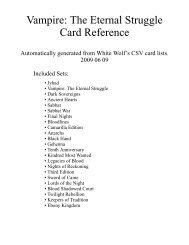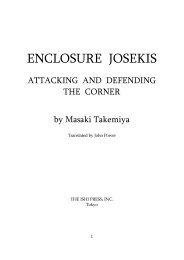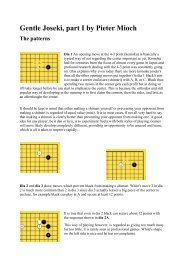Plains Cree: A Grammatical Study - Computer Science Club
Plains Cree: A Grammatical Study - Computer Science Club
Plains Cree: A Grammatical Study - Computer Science Club
Create successful ePaper yourself
Turn your PDF publications into a flip-book with our unique Google optimized e-Paper software.
34 [TRANS. AMER. PHIL. SOC.<br />
4.12. awina 'who'<br />
awtna 'who' has only animate forms:<br />
3 awmna<br />
3p awiniki<br />
3' awinihi<br />
WOLFART: PLAINS CREE<br />
4.121. awina has two distinct but clearly related<br />
uses. As an interrogative pronoun, awina shows<br />
concord with the other nominal or pronominal expressions<br />
in a sentence. Having animate forms only, it is<br />
complemented in this function by the inanimate<br />
interrogative kikway (4.31).<br />
awmna may occur by itself, e.g. T10p89 eha, awmna?<br />
'Yes, who?'; T10p7 awTn etokwe. "Who, I wonder';<br />
T520p7, 8 awiniki kanihk. 'Who are they, then?'<br />
P72-4 "kitdnisindw eh-witapimdt ndpewa." "awinihi?"<br />
itwew kiseyiniw. ' "Our daughter is sitting by the side<br />
of a man (3')." "Who is he," said the old man.'<br />
It may occur as part of an equational sentence, e.g.,<br />
T27p2, 3 awina naha nete. 'Who is that one yonder?'<br />
awina ana naha kd-pe-sdkewet. 'Who is that, that<br />
one yonder, coming into the open?'<br />
Or it may function predicatively with a conjunct<br />
clause depending on it, e.g., T10pl2 awina ekosi<br />
e-itwet. 'Who says so?' T54p3 awina kd-nakatiht.<br />
'Who was left behind (indf-3)?'<br />
4.122. In combination with a following demonstrative,<br />
awina expresses surprise, e.g., T504p2 awana<br />
ana . . . 'Who (was it but) that one ... .<br />
In this function, awina is not usually inflected (but<br />
see P98-5); thus, we find it with any inflected form,<br />
of either gender, of the demonstratives; e.g., T73p15<br />
awmn es ohi (3') ekota owLkimdkana (3') ki-apiyiwa<br />
(3'), . . . 'What was this (3'), his wife (3') sat (3')<br />
there, . . .'; T103p4 aspin esa awina oma watihk.<br />
'Away (she went), lo and behold, into a hole.'<br />
Where it expresses surprise, awina exactly parallels<br />
the particle pdti, e.g., T46p6 pot dhi (3') esa owikimdkana<br />
(3') . . . 'What was that (3') but her husband<br />
(3') . . '<br />
4.123. The stem awin- also occurs with the suffix<br />
/epan/ 'former, absent' which in this environment is<br />
mutually exclusive with the number-obviation endings;<br />
cf. 3.5, 5.321. Thus, T115p8 awtnipan ocahpihcisa<br />
'gone was his tobacco-pouch (3').'<br />
Much like its counterpart nama klkway (4.323),<br />
awmnipan most typically means 'not here any more';<br />
in this form, too, there is clearly an element of surprise<br />
(cf. 4.122 above). Thus, T18-8 wiyapaniyik e-koskopayit,<br />
awmnipan otema (3'). 'When he got up the<br />
next morning, his horse (3') was gone'; T28p10<br />
e-apasdpit, awlnipan. 'When he looked back:<br />
nobody.'<br />
awinipan may even occur in collocation with an<br />
inanimate noun and, indeed, together with kikway:<br />
T125-6 awmnipan oma mikiwdhpis. 'That wigwam<br />
(0) was gone!' T125-8 .. . -nandtawdpit, awinipan<br />
kikway, awtnipan oma mikiwdhpis. '. . . when he<br />
looked around, nothing, that wigwam (0) was gone!'<br />
4.13. tdni 'which'<br />
tdn- is a delimiting interrogative.<br />
3<br />
3p<br />
3'<br />
0<br />
Op op<br />
tini<br />
tdniki<br />
tdnihi<br />
tdni, tdnima<br />
tanihi<br />
The inanimate singular form is problematic; the<br />
variant one would expect in this paradigm is tdnima.<br />
tdnima is homonymous with a particle meaning 'how<br />
much, where' (which presumably developed from the<br />
pronoun), and this may well be the reason for the<br />
spreading of tdni.<br />
Just like the numerous particles based on the root<br />
tan-, the delimiting interrogative tan- functions<br />
primarily as a conjunction, e.g., T28p3 mdnakisk<br />
tdnihi ekoni e-wiyinoyit e-ati-pimikwepitdt . . .<br />
'Then, which ever ones (3') were fat (3'), of those<br />
(3') he twisted the neck (3-(3')) . . . .' S280-8<br />
tdnimah kostahkih, otah k-esiwepinanaw. 'Whichever<br />
he fears, there we shall throw him.' tdni also occurs<br />
with the pronoun ana as predication: P200-31 tdn ana<br />
mdka eh-okimdwit . 'But which is the one who<br />
is the chief . .'; P280-1 tdn dnim dyi okimdw<br />
wkkih? 'Which is the chief's tent?' tdni is typically<br />
counterbalanced by the delimiting demonstrative<br />
ewako (4.41) or by a particle based on the same root,<br />
e.g., ekota 'there': S103-24 ekwah tdnihi eh-wiyinoyit,<br />
ewakonih tehtapiw awa mistanask. 'Then whichever<br />
one was the fattest on this one Badger sat down';<br />
P222-32 tdn ewakw etoke mdka, ntdtem? 'But which<br />
one is it, Fellow-tribesman?' S129-46 ekwah tdnihi<br />
eh-miywdsiniyikih wiyasah, ekotah pdnahikeyiwah<br />
tawdsima. 'Then by the best stores of meat, there his<br />
children cleared away the snow.'<br />
4.2. PRONOMINAL PARADIGM II<br />
The pronominal paradigm II has the following<br />
basic set of endings.<br />
3<br />
3p<br />
3'<br />
0<br />
Op<br />
-a<br />
-ehkdk<br />
-ehd<br />
-e<br />
The pronouns of this type are not common in texts;<br />
only the tdniwd paradigm is fully exemplified in<br />
recently collected texts.<br />
4.21. tdniwd, ewakwd 'where is he, there he is'<br />
tdniwd 'where is he' and ewakwd 'there he is' are<br />
verb-substitutes which might well be called "ex-<br />
istential" pronouns. They function as predications



